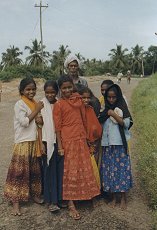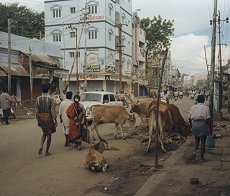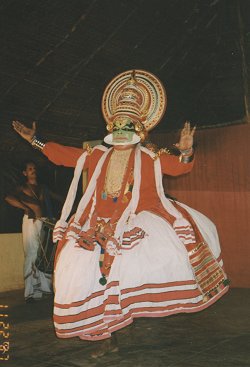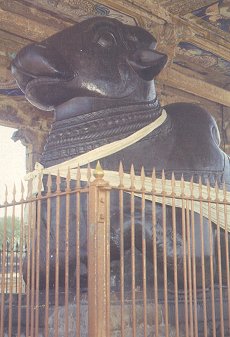South India - a few personal thoughts and reminiscences of a holiday.
November 1997
 Everyone knows it instinktively (sic).
It’s something that is always near the surface in any consideration of India -
indeed it’s on the surface in many places. Shoes develop their own ESP to it
(after about a week). Yet nobody in India talks about it. It’s as if it only
exists for some people, and for others it’s almost invisible and without odour
- unless, of course, you are a visitor! The last time I was in India I think
that by virtue of travelling in an air-con coach and staying in 3* Hotels, I
was shielded from the real, raw India - this time I was not!
Everyone knows it instinktively (sic).
It’s something that is always near the surface in any consideration of India -
indeed it’s on the surface in many places. Shoes develop their own ESP to it
(after about a week). Yet nobody in India talks about it. It’s as if it only
exists for some people, and for others it’s almost invisible and without odour
- unless, of course, you are a visitor! The last time I was in India I think
that by virtue of travelling in an air-con coach and staying in 3* Hotels, I
was shielded from the real, raw India - this time I was not!
The problem throughout India is a lack of good infrastructure whether it be roads, sewage, housing, health and welfare, contraception, Town planning; the kind of things which we tend to take for granted. And with their speed of growth and the rush to be part of the twentieth century, they can never build or change quickly enough before, yet again, their sheer numbers and ad hoc development has left the vision far behind.

Perhaps the British could have served India better if they had put in a sewage system and motorways as well as the railway, but of course it was the British East India Company who put in much of the railway as a means to transport goods for their business ventures - it had nothing to do with making things easier and nicer for the advent of mass tourism!.
The railways are a wonderful way for an independent visitor to travel around the country. An Indrail pass gives you access to any train, anywhere. The rolling stock is pretty ancient and bottom class seats are uncomfortably wooden; many of the routes are single track, so hours are spent waiting on sidings for the opposite train to pass. But in First Class a/c (air conditioned) food is brought round for you to eat if you dare, sweet coffee or tea costs Rupees 3 (about 5p) and at night a pillow, sheet and blanket are provided so that you can sleep for the main part of the journey ! We spent 5 nights on trains and arrived at the next destination ready to sight-see almost immediately.
Our ventures onto the roads were always full of trepidation, whether travelling by bus, coach, auto-rickshaw or cycle-rickshaw. Roads are used by the whole range of Indian life - the agricultural worker with his bullock drawn cart, the cow herd with his group of cows or water buffalo, the goats, pigs, dogs, chickens as well as the crazily driven local and inter-state buses, antiquated lorries with bald tyres, private cars, taxis, motorbikes - (the middle class mode of family transport), rickshaws, cycles, pedestrians etc. Lane discipline and signalling are unheard of, although ‘horning’ - the ubiquitous and blatant use of long, deafening blasts on the horn to announce your wish to overtake - was sometimes headache inducing. Add to that the smog produced by hundreds of 2-stroke auto rickshaws in the urban situation and travelling can prove injurious to health!

Not surprisingly accidents are frequent although perplexingly, road rage isn’t!
Outside the towns the countryside was glorious. Everywhere was lush greenness. It seems as if the whole of Southern India is cultivated, mainly rice paddies, coconut and banana groves and sugar cane. There was abundant water and all looked well husbanded although highly labour intensive. As we travelled in the train we saw field on field of women in their colourful sarees planting rice, great arching trees planted to give shade, many of the flowering trees and shrubs being similar to the ones that grow here in Cyprus. The bird life was interesting too, dainty white egrets fed in the rice fields and accompanied every grazing cow. Pariah and Brahminy kites circled lazily overhead in the towns and villages often being mobbed by arrogant and noisy crows. We saw loads of gloriously coloured Kingfishers, Rollers and Bee-eaters as they sat on telegraph wires watching for the small movement of a frog or fish in the ponds and rivers.
The villages we passed through when we travelled by hired car were, on the surface, idyllic and had all the visual sights that we associate with ‘romantic’ village life. On closer inspection they have no running water in their mud and palm leaf houses, washing has to be done in the local stream water along with many other human functions. The snuffling pigs and families of ‘eat anything’ goats live very close. Cooking facilities are primitive. Paths are mud and often muddy or dusty.
The glorious colours of India are
nowhere better seen than in the variety of sarees worn by the married women.
Their complexions enhance the orchid pinks, cherry reds, royal blues, emerald
greens and every colour in between. They look graceful even when working on
building sites or by the roadside breaking rocks - jobs that probably earn
them no more than £1.00 a day. The men wear lungi’s - coloured waist to floor
wrap-overs, which they fold up to knee height if they are getting in the way
or too hot. In choosing when to go to India we hoped to miss the monsoons and
mega-heat of the summer. We did. But in southern Kerala the mix of 30°C plus
high humidity was very exhausting. By far the best climate was in Mysore,
warm, sunny and low humidity. It was also lovely to take a few days and relax
by the Arabian Sea. The beaches were reasonably clean although tourists are
constant targets for beach sellers. We lazed, read and at night ate looking
out over a moonlit sea in warm balmy breezes. 
The offers of ‘grass’ to further relax our minds and bodies we declined, but observed many whose perception was obviously enhanced!
For many years I have spent hours reading various travel books and brochures on India. My 1985 Fodor has wonderful descriptions of the religious and cultural heritage of India - it talks of towering statue covered Gopura, awesome 1000 pillared halls, majestic Mandapas and huge Shiva lingams. I wanted to see all these things for myself, the ancient monolithic temples at Mahaballipuram, the vast deserted city of Hampi, the exquisitely carved Hoysala temple at Somnathpur and most of all the impressive temple complex at Tanjavor with a black granite carving of Nandi the Bull, 16 feet long.

We saw all of these and loads more until we felt that another temple would send us into overload!
The adjectives I have used are the ones in the 1985 Fodor book, and they are still relevant, the feats of monumental building still stand testimony to one of the most amazing and prolific flowerings of architecture in the world. We were both very impressed with India’s heritage.
South Indian food is spicy. The west coast State of Kerala is where a lot of spices are grown so I suppose it’s obvious. The staple lunch is a Thali. A mountain of boiled rice with about 4 or 5 very spicy, watery accompaniments which you are expected to work into the rice and convey to the mouth with just the right hand. It’s amazingly cheap - about 40p! We tried it a few times but got bored quite quickly. And as you would expect, foreigners have to be careful about food hygiene. The rule is : if it’s boiled, baked or peeled - it’s OK, otherwise forget it!.
I thought that I was quite good at bartering; employing histrionic actions like brushing forehead with palm of hand while exclaiming ‘You must be joking!’ ‘That’s off the Wall!’ or ‘ Much too much’. And I found that I got an immense high from buying something that I had bartered hard for. Walking down a street market in Madras I decided that I would buy some lungi’s for presents. I asked the price and was told ‘75 Rupees’ - I went through my routine of forehead bashing, tooth sucking and raising eyes heavenwards - and finally achieved what I thought was a good price - R60. Bought four. Big mistake. Further down the market I stupidly asked another stallholder how much his lungi’s were...... ‘R60’ he replied. Go through my head bashing routine again, to get an immediate capitulation .... ‘OK, 40 Rupees!’ We didn’t buy all that much as we had to carry everything in our rucksacks, but Brian bought 2 Indian printed Computer books for about one sixth the price in UK., and a pair of lightweight prescription bifocals for £25.00. Some things are amazingly cheap.
If anyone wants to travel Southern India fairly soon, we’d be happy to suggest good hotels and places to visit - we know we could have improved on our itinerary if we were to do the same thing again, but in looking back, we would not have missed the experience.